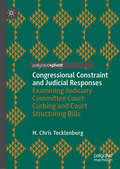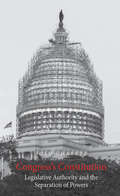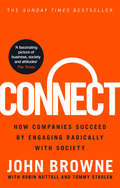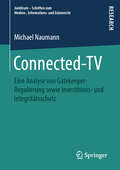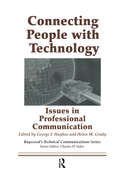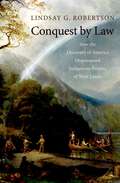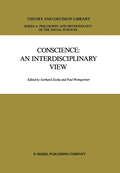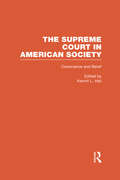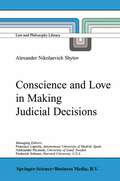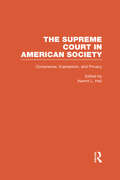- Table View
- List View
Congressional Constraint and Judicial Responses: Examining Judiciary Committee Court Curbing and Court Structuring Bills
by H. Chris TecklenburgThis book examines the relationship between Congress and the Federal Judiciary over time. Several aspects of this separation of power dynamics are examined, including court curbing legislation, court structuring legislation, justiciability, and judicial review. Unlike prior works, this book examines this relationship from a bicameral perspective, as it is argued that there are different motivations and reasons as to why and how each chamber of Congress approaches its relationship with the federal judiciary. In addition, this book considers the role of the judiciary committee in the legislative process, as bills that were reported out of committee are examined. Several possible causes of this legislative activity and judicial responses are analyzed, including polarization, judicial review, unanimity on the court, the changing issue agenda of the Court, ideological institutional distance, and divided government. The results reveal that there are important differences with regard to how the chambers interact with the federal judiciary.
Congress's Constitution: Legislative Authority and the Separation of Powers
by Josh ChafetzA leading scholar of Congress and the Constitution analyzes Congress’s surprisingly potent set of tools in the system of checks and balances. Congress is widely supposed to be the least effective branch of the federal government. But as Josh Chafetz shows in this boldly original analysis, Congress in fact has numerous powerful tools at its disposal in its conflicts with the other branches. These tools include the power of the purse, the contempt power, freedom of speech and debate, and more. Drawing extensively on the historical development of Anglo-American legislatures from the seventeenth century to the present, Chafetz concludes that these tools are all means by which Congress and its members battle for public support. When Congress uses them to engage successfully with the public, it increases its power vis-à-vis the other branches; when it does not, it loses power. This groundbreaking take on the separation of powers will be of interest to both legal scholars and political scientists.
Connect: How companies succeed by engaging radically with society
by John Browne Robin Nuttall Tommy StadlenThe Sunday Times Top Ten Bestseller.Drawing on the experience of John Browne, former CEO of BP, and the insight of two McKinsey experts, Connect articulates and explores the recurring rift between big business and society, offering a practical manifesto for reconciliation. This timely and important book features candid interviews with global leaders at the heart of this debate, from Facebook’s Sheryl Sandberg and Goldman Sachs’ CEO Lloyd Blankfein to Tony Blair and Tim Berners-Lee, inventor of the World Wide Web.Connect shows how companies and executives can enhance their performance by engaging radically with the world around them.
Connected and Associated: Insolvency and Pensions Law
by David PollardConnected and Associated: Insolvency and Pensions Law discusses, in detail, the meaning and scope of the 'connected', 'associated' and 'control' tests used in the Insolvency Act 1986. These are in sections 249 and 435, and are incorporated by reference in pensions legislation. It also looks at the linked connected person test in The Administration (Restrictions on Disposal etc. to Connected Persons) Regulations 2021.Connected and Associated: Insolvency and Pensions Law will help you to:- Decide whether a person is connected or associated with another under the insolvency test for the purposes of preferences, transactions at an undervalue, or voting in creditor meetings- Decide whether there is a risk of falling within the potential target net for a contribution notice or financial support direction under the moral hazard powers of the Pensions Regulator in the Pensions Act 2004- Check whether an investment by a pension scheme is within the limits on employer-related investment under the Pensions Act 1995- Work out when a disposal by an administrator will be to a connected person - Work out who satisfies the independence test for an evaluator - Deal with connected person voting majorities in a creditor vote in a CVA and a Part A1 Moratorium- Understand the implications of the Administration (Restriction on Disposal etc. to Connected Persons) Regulations 2021Written by David Pollard, one of the leading experts in this field, this is the only in-depth review of the complex test for connected or associated persons and, as such, is an essential title for insolvency and pension lawyers, litigators, pension trustees, employers, investors, lenders and their advisers.David Pollard is a leading and highly experienced lawyer in the insolvency and pensions fields and in related areas. He is a barrister, practising from Wilberforce Chambers in Lincoln's Inn, and previously practised for 37 years as a solicitor in London and Singapore. David's practice focuses on pensions law; insolvency law and; employment law (involving pensions). He was Chairman of the Association of Pension Lawyers (APL) from 2001 to 2003 and has been a vice chair of the Industrial Law Society.
Connected and Automated Vehicles: Integrating Engineering and Ethics (Studies in Applied Philosophy, Epistemology and Rational Ethics #67)
by Fabio Fossa Federico CheliThis book reports on theoretical and practical analyses of the ethical challenges connected to driving automation. It also aims at discussing issues that have arisen from the European Commission 2020 report “Ethics of Connected and Automated Vehicles. Recommendations on Road Safety, Privacy, Fairness, Explainability and Responsibility”. Gathering contributions by philosophers, social scientists, mechanical engineers, and UI designers, the book discusses key ethical concerns relating to responsibility and personal autonomy, privacy, safety, and cybersecurity, as well as explainability and human-machine interaction. On the one hand, it examines these issues from a theoretical, normative point of view. On the other hand, it proposes practical strategies to face the most urgent ethical problems, showing how the integration of ethics and technology can be achieved through design practices. All in all, this book fosters a multidisciplinary approach where philosophy, ethics, and engineering are integrated, rather than just juxtaposed. It is meant to inform and inspire an audience of philosophers of technology, ethicists, engineers, developers, manufacturers, and regulators, among other interested readers.
Connected-TV: Eine Analyse von Gatekeeper-Regulierung sowie Investitions- und Integritätsschutz (Juridicum – Schriften zum Medien-, Informations- und Datenrecht)
by Michael NaumannMichael Naumann befasst sich mit juristischen Fragestellungen zu Connected-TVs unter Einbeziehung neuster legislativer und medienpolitischer Entwicklungen. Der Autor arbeitet heraus, dass das abgestufte System zur Regulierung elektronischer Kommunikationsinhalte auf inhaltlicher Ebene kritikwürdig ist. Er zeigt auf, welche Funktionen vernetzter Fernsehgeräte Gatekeeper-Stellungen begründen, die unter den verfassungsrechtlichen Geboten der Vielfaltssicherung und kommunikativer Chancengleichheit regulierungsbedürftig erscheinen. Unter diesen Prämissen widmet er sich der Plattformregulierung und entwickelt ein eigenes System, welches Plattformen je nach Grad ihrer Ausschließlichkeit erfasst. Er untersucht das Urheber-, das Wettbewerbs- sowie das Rundfunkrecht auf ihre Tauglichkeit zum Schutz der Integrität von Programminhalten und hinsichtlich eines Investitionsschutzes für Rundfunkanbieter.
Connecting People with Technology: Issues in Professional Communication (Baywood's Technical Communications)
by George F. HayhoeThis book explores five important areas where technology affects society, and suggests ways in which human communication can facilitate the use of that technology.Usability has become a foundational discipline in technical and professional communication that grows out of our rhetorical roots, which emphasize purpose and audience. As our appreciation of audience has grown beyond engineers and scientists to lay users of technology, our appreciation of the diversity of those audiences in terms of age, geography, and other factors has similarly expanded.We are also coming to grips with what Thomas Friedman calls the 'flat world,' a paradigm that influences how we communicate with members of other cultures and speakers of other languages. And because most of the flatteners are either technologies themselves or technology-driven, technical and professional communicators need to leverage these technologies to serve global audiences.Similarly, we are inundated with information about world crises involving health and safety issues. These crises are driven by the effects of terrorism, the aging population, HIV/AIDS, and both human-made and natural disasters. These issues are becoming more visible because they are literally matters of life and death. Furthermore, they are of special concern to audiences that technical and professional communicators have little experience targeting - the shapers of public policy, seniors, adolescents, and those affected by disaster.Biotechnology is another area that has provided new roles for technical and professional communicators. We are only beginning to understand how to communicate the science accurately without either deceiving or panicking our audience. We need to develop a more sophisticated understanding of how communication can shape reactions to biotechnology developments. Confronting this complex network of issues, we're challenged to fashion both our message and the audience's perceptions ethically.Finally, today's corporate environment is being shaped by technology and the global nature of business. Technical and professional communicators can play a role in capturing and managing knowledge, in using technology effectively in the virtual workplace, and in understanding how language shapes organizational culture.
Connecting People with Technology: Issues in Professional Communication (Baywood's Technical Communications)
by George Hayhoe Helen M. M. GradyThis book explores five important areas where technology affects society, and suggests ways in which human communication can facilitate the use of that technology.Usability has become a foundational discipline in technical and professional communication that grows out of our rhetorical roots, which emphasize purpose and audience. As our appreciation of audience has grown beyond engineers and scientists to lay users of technology, our appreciation of the diversity of those audiences in terms of age, geography, and other factors has similarly expanded.We are also coming to grips with what Thomas Friedman calls the 'flat world,' a paradigm that influences how we communicate with members of other cultures and speakers of other languages. And because most of the flatteners are either technologies themselves or technology-driven, technical and professional communicators need to leverage these technologies to serve global audiences.Similarly, we are inundated with information about world crises involving health and safety issues. These crises are driven by the effects of terrorism, the aging population, HIV/AIDS, and both human-made and natural disasters. These issues are becoming more visible because they are literally matters of life and death. Furthermore, they are of special concern to audiences that technical and professional communicators have little experience targeting - the shapers of public policy, seniors, adolescents, and those affected by disaster.Biotechnology is another area that has provided new roles for technical and professional communicators. We are only beginning to understand how to communicate the science accurately without either deceiving or panicking our audience. We need to develop a more sophisticated understanding of how communication can shape reactions to biotechnology developments. Confronting this complex network of issues, we're challenged to fashion both our message and the audience's perceptions ethically.Finally, today's corporate environment is being shaped by technology and the global nature of business. Technical and professional communicators can play a role in capturing and managing knowledge, in using technology effectively in the virtual workplace, and in understanding how language shapes organizational culture.
Conquest by Law: How the Discovery of America Dispossessed Indigenous Peoples of Their Lands
by Lindsay G. RobertsonIn 1823, Chief Justice John Marshall handed down a Supreme Court decision of monumental importance in defining the rights of indigenous peoples throughout the English-speaking world. At the heart of the decision for Johnson v. M'Intosh was a "discovery doctrine" that gave rights of ownership to the European sovereigns who "discovered" the land and converted the indigenous owners into tenants. Though its meaning and intention has been fiercely disputed, more than 175 years later, this doctrine remains the law of the land. In 1991, while investigating the discovery doctrine's historical origins Lindsay Robertson made a startling find; in the basement of a Pennsylvania furniture-maker, he discovered a trunk with the complete corporate records of the Illinois and Wabash Land Companies, the plaintiffs in Johnson v. M'Intosh. Conquest by Law provides, for the first time, the complete and troubling account of the European "discovery" of the Americas. This is a gripping tale of political collusion, detailing how a spurious claim gave rise to a doctrine--intended to be of limited application--which itself gave rise to a massive displacement of persons and the creation of a law that governs indigenous people and their lands to this day.
Conquest by Law: How the Discovery of America Dispossessed Indigenous Peoples of Their Lands
by Lindsay G. RobertsonIn 1823, Chief Justice John Marshall handed down a Supreme Court decision of monumental importance in defining the rights of indigenous peoples throughout the English-speaking world. At the heart of the decision for Johnson v. M'Intosh was a "discovery doctrine" that gave rights of ownership to the European sovereigns who "discovered" the land and converted the indigenous owners into tenants. Though its meaning and intention has been fiercely disputed, more than 175 years later, this doctrine remains the law of the land. In 1991, while investigating the discovery doctrine's historical origins Lindsay Robertson made a startling find; in the basement of a Pennsylvania furniture-maker, he discovered a trunk with the complete corporate records of the Illinois and Wabash Land Companies, the plaintiffs in Johnson v. M'Intosh. Conquest by Law provides, for the first time, the complete and troubling account of the European "discovery" of the Americas. This is a gripping tale of political collusion, detailing how a spurious claim gave rise to a doctrine--intended to be of limited application--which itself gave rise to a massive displacement of persons and the creation of a law that governs indigenous people and their lands to this day.
The Conquest of Death: Violence and the Birth of the Modern English State
by Matthew LockwoodA fresh and fascinating history of crime and violence in England through the office of the coroner In his fascinating debut, Matthew Lockwood explores the history of crime, homicide, and suicide in England over four centuries through the office of the coroner. While the office was established to investigate violent or suspicious deaths, Lockwood asserts that the demands of competing parties gradually shaped its systems and transformed England into a modern state earlier than is commonly acknowledged. Weaving together strands of social, legal, economic, and political history, this book will interest scholars across a range of fields.
Conscience: Salzburg Colloquium on Ethics in the Sciences and Humanities (Theory and Decision Library A: #1)
by G. Zecha P. WeingartnerValue change and uncertainty about the validity of traditional moral convictions are frequently observed when scientific re search confronts us with new moral problems or challenges the moral responsibility of the scientist. Which ethics is to be relied on? Which principles are the most reasonable, the most humane ones? For want of an appropriate answer, moral authorities of ten point to conscience, the individual conscience, which seems to be man's unique, directly accessible and final source of moral contention. But what is meant by 'conscience'? There is hardly a notion as widely used and at the same time as controversial as that of conscience. In the history of ethics we can distinguish several trends in the interpretation of the concept and function of conscience. The Greeks used the word O"uvEt81lm~ to denote a kind of 'accompa nying knowledge' that mostly referred to negatively experienced behavior. In Latin, the expression conscientia meant a knowing together pointing beyond the individual consciousness to the common knowledge of other people. In the Bible, especially in the New Testament, O"uvEt81l0"t~ is used for the guiding con sciousness of the morality of one's own action.
Conscience and Belief: The Supreme Court in American Society
by Kermit L. HallAvailable as a single volume or as part of the 10 volume set Supreme Court in American Society
Conscience and Belief: The Supreme Court in American Society (The\supreme Court In American Society Ser. #Vol. 8)
by Kermit L. HallAvailable as a single volume or as part of the 10 volume set Supreme Court in American Society
Conscience and Calling: Ethical Reflections on Catholic Women's Church Vocations
by Anne E. PatrickThis volume probes the meaning and ethical implications of the powerful symbol of vocation from the vantage of contemporary Catholic women, with particular attention to the experiences of women religious. Intended as a follow-up to Liberating Conscience: Feminist Explorations in Catholic Moral Theology, the new book will benefit many readers, including Catholic leaders, laity, and religious, as well as persons interested in Christian ethics and American religious history more generally. The work treats twentieth-century history and more recent developments, including tensions between the Vatican and progressive Catholics, the development of lay ministries, and the movement to ordain women deacons, priests, and bishops.
Conscience and Calling: Ethical Reflections on Catholic Women's Church Vocations
by Anne E. PatrickThis volume probes the meaning and ethical implications of the powerful symbol of vocation from the vantage of contemporary Catholic women, with particular attention to the experiences of women religious. Intended as a follow-up to Liberating Conscience: Feminist Explorations in Catholic Moral Theology, the new book will benefit many readers, including Catholic leaders, laity, and religious, as well as persons interested in Christian ethics and American religious history more generally. The work treats twentieth-century history and more recent developments, including tensions between the Vatican and progressive Catholics, the development of lay ministries, and the movement to ordain women deacons, priests, and bishops.
Conscience and Love in Making Judicial Decisions (Law and Philosophy Library #54)
by Alexander Nikolaevich ShytovTHE CONSCIENCE OF JUDGES AND APPLICA nON OF LEGAL RULES The book is devoted to the problem of the influence of moral judgements on the result of judicial decision-making in the process of application of the established (positive) law. It is the conscience of judges that takes the central place in the research. Conscience is understood in the meaning developed in the theory of Thomas Aquinas as the complex capacity of the human being to make moral judgements which represent acts of reason on the question of what is right or wrong in a particular situation. The reason why we need a theory of conscience in making judicial decisions lies in the nature of the positive law itself. On the one hand, there is an intrinsic conflict between the law as the body of rigid rules and the law as an living experience of those who are involved in social relationships. This conflict particularly finds its expression in the collision of strict justice and equity. The idea of equity does not reject the importance of rules in legal life. What is rejected is an idolatrous attitude to the rules when the uniqueness of a human being, his well being and happiness are disregarded and sacrificed in order to fulfil the observance of the rules. The rules themselves are neither good or bad. What makes them good or bad is their application.
Conscience and the Constitution: History, Theory, and Law of the Reconstruction Amendments (PDF)
by David A. RichardsAt stage center of the American drama, maintains David A. J. Richards, is the attempt to understand the implications of the Reconstruction Amendments--Amendments Thirteen, Fourteen, and Fifteen to the United States Constitution. Richards evaluates previous efforts to interpret the amendments and then proposes his own view: together the amendments embodied a self-conscious rebirth of America's revolutionary, rights-based constitutionalism. Building on an approach to constitutional law developed in his Toleration and the Constitution and Foundations of American Constitutionalism, Richards links history, law, and political theory. In Conscience and the Constitution, this method leads from an analysis of the Reconstruction Amendments to a broad discussion of the American constitutional system as a whole.Richards's interpretation focuses on the abolitionists and their radical commitment to the "dissenting conscience." In his view, the Reconstruction Amendments expressed not only the constitutional arguments of a particular historical period but also a general political theory developed by the abolitionists, who restructured the American political community in terms of respect for universal human rights. He argues further that the amendments make a claim on our generation to keep faith with the vision of the "founders of 1865." In specific terms he points out what such allegiance would mean in the context of present-day constitutional issues.Originally published in 1993.The Princeton Legacy Library uses the latest print-on-demand technology to again make available previously out-of-print books from the distinguished backlist of Princeton University Press. These editions preserve the original texts of these important books while presenting them in durable paperback and hardcover editions. The goal of the Princeton Legacy Library is to vastly increase access to the rich scholarly heritage found in the thousands of books published by Princeton University Press since its founding in 1905.
Conscience, Equity And The Court Of Chancery In Early Modern England
by Dennis R. KlinckJudicial equity developed in England during the medieval period, providing an alternative access to justice for cases that the rigid structures of the common law could not accommodate. Where the common law was constrained by precedent and strict procedural and substantive rules, equity relied on principles of natural justice - or 'conscience' - to decide cases and right wrongs. Overseen by the Lord Chancellor, equity became one of the twin pillars of the English legal system with the Court of Chancery playing an ever greater role in the legal life of the nation. Yet, whilst the Chancery was commonly - and still sometimes is - referred to as a 'court of conscience', there is remarkably little consensus about what this actually means, or indeed whose conscience is under discussion. This study tackles the difficult subject of the place of conscience in the development of English equity during a crucial period of legal history. Addressing the notion of conscience as a juristic principle in the Court of Chancery during the sixteenth and seventeenth centuries, the book explores how the concept was understood and how it figured in legal judgment. Drawing upon both legal and broader cultural materials, it explains how that understanding differed from modern notions and how it might have been more consistent with criteria we commonly associate with objective legal judgement than the modern, more 'subjective', concept of conscience. The study culminates with an examination of the chancellorship of Lord Nottingham (1673-82), who, because of his efforts to transform equity from a jurisdiction associated with discretion into one based on rules, is conventionally regarded as the father of modern, 'systematic' equity. From a broader perspective, this study can be seen as a contribution to the enduring discussion of the relationship between 'formal' accounts of law, which see it as systems of rules, and less formal accounts, which try to make room for intuitive moral or prudential reasoning.
Conscience, Equity And The Court Of Chancery In Early Modern England
by Dennis R. KlinckJudicial equity developed in England during the medieval period, providing an alternative access to justice for cases that the rigid structures of the common law could not accommodate. Where the common law was constrained by precedent and strict procedural and substantive rules, equity relied on principles of natural justice - or 'conscience' - to decide cases and right wrongs. Overseen by the Lord Chancellor, equity became one of the twin pillars of the English legal system with the Court of Chancery playing an ever greater role in the legal life of the nation. Yet, whilst the Chancery was commonly - and still sometimes is - referred to as a 'court of conscience', there is remarkably little consensus about what this actually means, or indeed whose conscience is under discussion. This study tackles the difficult subject of the place of conscience in the development of English equity during a crucial period of legal history. Addressing the notion of conscience as a juristic principle in the Court of Chancery during the sixteenth and seventeenth centuries, the book explores how the concept was understood and how it figured in legal judgment. Drawing upon both legal and broader cultural materials, it explains how that understanding differed from modern notions and how it might have been more consistent with criteria we commonly associate with objective legal judgement than the modern, more 'subjective', concept of conscience. The study culminates with an examination of the chancellorship of Lord Nottingham (1673-82), who, because of his efforts to transform equity from a jurisdiction associated with discretion into one based on rules, is conventionally regarded as the father of modern, 'systematic' equity. From a broader perspective, this study can be seen as a contribution to the enduring discussion of the relationship between 'formal' accounts of law, which see it as systems of rules, and less formal accounts, which try to make room for intuitive moral or prudential reasoning.
Conscience, Expression, and Privacy: The Supreme Court in American Society
by Kermit L. HallAvailable as a single volume or as part of the 10 volume set Supreme Court in American Society
Conscience, Expression, and Privacy: The Supreme Court in American Society (The\supreme Court In American Society Ser. #Vol. 9)
by Kermit L. HallAvailable as a single volume or as part of the 10 volume set Supreme Court in American Society
Conscience in Reproductive Health Care: Prioritizing Patient Interests
by Carolyn McLeodConscience in Reproductive Health Care responds to the growing worldwide trend of health care professionals conscientiously refusing to provide abortions and similar reproductive health services in countries where these services are legal and professionally accepted. Carolyn McLeod argues that conscientious objectors in health care should prioritize the interests of patients in receiving care over their own interest in acting on their conscience. She defends this "prioritizing approach" to conscientious objection over the more popular "compromise approach" without downplaying the importance of health care professionals having a conscience or the moral complexity of their conscientious refusals. McLeod's central argument is that health care professionals who are gatekeepers of services such as abortions are fiduciaries for their patients and for the public they are licensed to serve. As such, they owe a duty of loyalty to these beneficiaries and should give primacy to their beneficiaries' interests in accessing care. This conclusion is informed by what McLeod believes is morally at stake for the main parties to the conflicts generated by conscientious refusals: the objector and the patient. What is at stake, according to McLeod, depends on the relevant socio-political context, but typically includes the objector's integrity and the patient's interest in avoiding harm.
Conscience, Leadership and the Problem of 'Dirty Hands' (Research in Ethical Issues in Organizations #13)
by Howard Harris Michael Schwartz Sandra Lynch Matthew BeardThis volume contains a selection of papers from the 21st annual 'Australian Association for Professional and Applied Ethics' Conference. It addresses the key theme of Political Leadership, Professional Ethics, and the Problem of Dirty Hands. 'Dirty hands' is a somewhat nebulous concept. It may refer to professions whose objectives are so consequential that some ethical violations are considered justifiable. In another sense it might suggest situations where professional obligations might require the performance of deeds that contradict one's own moral beliefs. The term is perhaps most synonymous with political leadership and raises the question: Should leaders ever get their hands dirty? For applied ethicists, recognizing that sometimes there are compelling arguments in favor of certain moral violations is a professional necessity. This volume contains papers on a broad range of issues including discussions of medical ethics, military ethics, domestic political matters, and the very nature of 'professions' themselves. It will be of interest to those interested in politics, as well as those involved in research or training in ethics and professional practice.
The Conscience of the Autobiographer: Ethical and Religious Dimensions of Autobiography (Studies in Literature and Religion)
by J. BarbourThis book argues that the writing of autobiography raises crucial issues of conscience as an author tries to know, assess, and represent character. Individual chapters explore such issues as the nature of truthfulness, characterization, the virtues, shame, and the religious dimensions of conscience.
